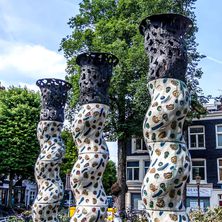

Named after the painter Gerard Dou, one of Rembrandt's pupils, this cozy little square was constructed around the end of the 19th century and was, at the time, one of the few open spaces in this densely populated neighborhood. In the 1990s, when De Pijplost much of its proletarian character and young professionals, students and expats started taking over, the square rose in popularity as trendy cafes and restaurants started springing up around it and in the side streets. Gerard Douplein is the beating heart of De Pijp, a district popular with the younger crowd.
The eternally inquisitive keep on trying to guess how de Pijp (which translates into English as The Pipe) got its name, but the truth is evasive. Perhaps it owes its name to the long narrow streets that supposedly resemble pipes or to the eponymous gas company which used to supply the utilities to the area. Formerly a working class quarter built in the 19th century to ease the overpopulated Jordaan on the city's west side, today de Pijp is a bustling residential and commercial district that features the city's most famous and largest market, many stores and businesses and, by night and in the weekends, is a host to a thriving hip nightlife. Back in the early 20th century the neighborhood already possessed a Bohemian character, similar to that of the Latin Quarter in Paris, as students settled here thanks to cheaper rents. The proximity of the former State Art Academy on Stadhouderskade 86, now known as De Ateliers, also a renowned artist residence, gave the neighborhood such famous denizens as, for instance, the minimalist painter Mondriaan, who lived here during his student days. The skyrocketing rents as well as rising economic well-being has seen students giving way to the young professional families that have taken De Pijp over in the recent decades.